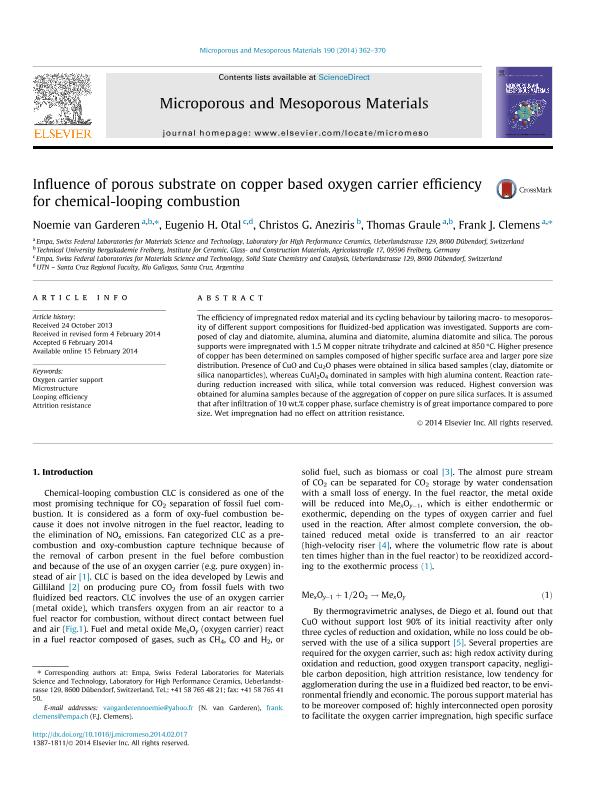Mostrar el registro sencillo del ítem
dc.contributor.author
van Garderen, Noemie
dc.contributor.author
Otal, Eugenio Hernan

dc.contributor.author
Aneziris, Christos G.
dc.contributor.author
Graule, Thomas
dc.contributor.author
Clemens, Frank J.
dc.date.available
2017-12-06T16:45:50Z
dc.date.issued
2014-02
dc.identifier.citation
van Garderen, Noemie; Otal, Eugenio Hernan; Aneziris, Christos G.; Graule, Thomas; Clemens, Frank J.; Influence of porous substrate on copper based oxygen carrier efficiency for chemical-looping combustion; Elsevier; Microporous and Mesoporous Materials; 190; 2-2014; 362-370
dc.identifier.issn
1387-1811
dc.identifier.uri
http://hdl.handle.net/11336/29829
dc.description.abstract
The efficiency of impregnated redox material and its cycling behaviour by tailoring macro- to mesoporosity of different support compositions for fluidized-bed application was investigated. Supports are composed of clay and diatomite, alumina, alumina and diatomite, alumina diatomite and silica. The porous supports were impregnated with 1.5 M copper nitrate trihydrate and calcined at 850 °C. Higher presence of copper has been determined on samples composed of higher specific surface area and larger pore size distribution. Presence of CuO and Cu2O phases were obtained in silica based samples (clay, diatomite or silica nanoparticles), whereas CuAl2O4 dominated in samples with high alumina content. Reaction rate during reduction increased with silica, while total conversion was reduced. Highest conversion was obtained for alumina samples because of the aggregation of copper on pure silica surfaces. It is assumed that after infiltration of 10 wt.% copper phase, surface chemistry is of great importance compared to pore size. Wet impregnation had no effect on attrition resistance.
dc.format
application/pdf
dc.language.iso
eng
dc.publisher
Elsevier

dc.rights
info:eu-repo/semantics/openAccess
dc.rights.uri
https://creativecommons.org/licenses/by-nc-nd/2.5/ar/
dc.subject
Oxygen Carrier Support
dc.subject
Microstructure
dc.subject
Looping Efficiency
dc.subject
Attrition Resistance
dc.subject.classification
Otras Ciencias Químicas

dc.subject.classification
Ciencias Químicas

dc.subject.classification
CIENCIAS NATURALES Y EXACTAS

dc.title
Influence of porous substrate on copper based oxygen carrier efficiency for chemical-looping combustion
dc.type
info:eu-repo/semantics/article
dc.type
info:ar-repo/semantics/artículo
dc.type
info:eu-repo/semantics/publishedVersion
dc.date.updated
2017-12-04T19:07:33Z
dc.journal.volume
190
dc.journal.pagination
362-370
dc.journal.pais
Estados Unidos

dc.journal.ciudad
Nueva York
dc.description.fil
Fil: van Garderen, Noemie. Eidgenössische Materialprüfungs- und Forschungsanstalt; Suiza. Technical University Bergakademie Freiberg. Institute for Ceramic, Glass- and Construction Materials; Alemania
dc.description.fil
Fil: Otal, Eugenio Hernan. Universidad Tecnológica Nacional. Facultad Regional Santa Cruz; Argentina. Consejo Nacional de Investigaciones Científicas y Técnicas. Unidad de Investigación y Desarrollo Estratégico para la Defensa. Ministerio de Defensa. Unidad de Investigación y Desarrollo Estratégico para la Defensa; Argentina. Eidgenössische Materialprüfungs- und Forschungsanstalt; Suiza
dc.description.fil
Fil: Aneziris, Christos G.. Technical University Bergakademie Freiberg. Institute for Ceramic, Glass- and Construction Materials; Alemania
dc.description.fil
Fil: Graule, Thomas. Eidgenössische Materialprüfungs- und Forschungsanstalt; Suiza. Technical University Bergakademie Freiberg. Institute for Ceramic, Glass- and Construction Materials; Alemania
dc.description.fil
Fil: Clemens, Frank J.. Eidgenössische Materialprüfungs- und Forschungsanstalt; Suiza
dc.journal.title
Microporous and Mesoporous Materials

dc.relation.alternativeid
info:eu-repo/semantics/altIdentifier/url/http://www.sciencedirect.com/science/article/pii/S138718111400078X
dc.relation.alternativeid
info:eu-repo/semantics/altIdentifier/doi/http://dx.doi.org/10.1016/j.micromeso.2014.02.017
Archivos asociados
